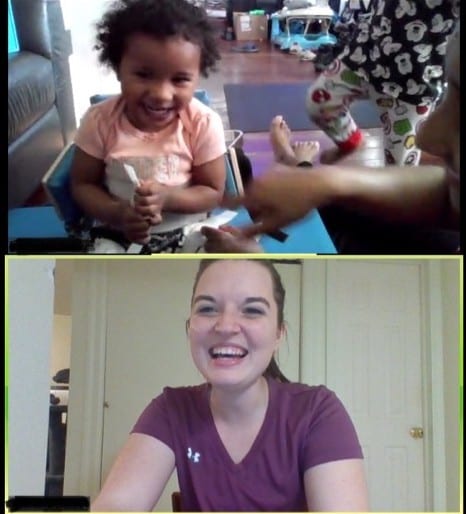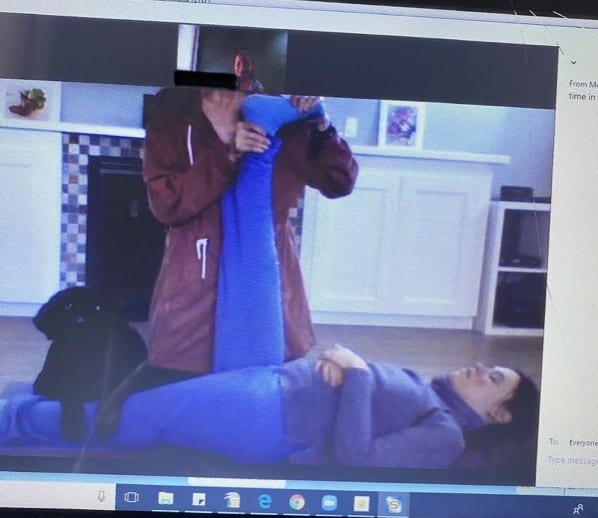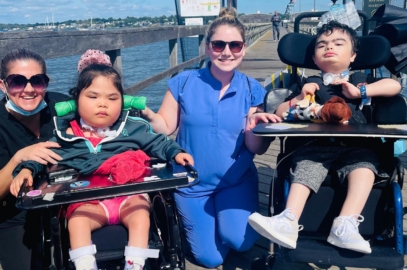April 23, 2020
At St. Mary’s Home Care, we believe that your home is the best place for our patients to thrive. We do all that we possibly can so that our children and young adults, with disabilities and medically complex conditions, can regain their independence and have a better quality of life with the family that loves them.
St. Mary’s Home Care is a special needs certified home health agency (CHHA) that is trusted by our families. St. Mary’s pioneered the first long-term pediatric home healthcare program more than 30 years ago. We remain one of the largest and most comprehensive providers of services to children with special healthcare needs and we deliver care to the homes of thousands of patients every day. St. Mary’s Home Care provides short-term skilled care for patients ranging in age from newborn to 44 years of age.
The Covid-19 pandemic has presented the St. Mary’s Home Care team with some daunting challenges – but true to form our team has been able to meet every single one of them! With the use of the internet, video conferencing, and communication resources, our teams have been able to safely communicate and message remotely.
The St. Mary’s Home Care Team has risen to the challenge of ensuring that all of our patients remain safe at home and continue to receive the services they need. Elvira Fardella-Roveto, RN, FNP-BC, Administrator and Director of Patient Services, is a fierce and determined advocate for our patients who has worked tirelessly to advocate with state agencies, legislators, and insurance companies on behalf of our patients and staff to prevent any disruptions in service during the crisis. In addition, all staff, from those in the office to those working remotely or out in the field, have gone above and beyond for St. Mary’s Home Care patients. Here are just a few of the many actions the staff have taken and some of the great success stories we are able to share:
All clinical staff, including nurses, physical therapists, speech therapists, occupational therapists, social workers and nutritionists embraced an expedited training on how to conduct virtual visits; developing new skills in the process. Staff are using very creative methods to engage their patients while ensuring their safety and well-being and in order to prevent their patients from regressing.
In order to not lose their CHHA services, one of our dedicated St. Mary’s Home Care nurses conducted a virtual telehealth visit with a non-English speaking family. St. Mary’s back office team arranged a video teleconference between the RN in the field, the Supervising RN in the Home Care office, the family, and the language interpreter so that the field RN would be able to have a visual “eyes on” the 3-year-old patient and ensure that the family understood the RN’s questions. As a result, we were able to complete the recertification visit on time to ensure the patient would not have a lapse in service that might result in medical complications. The child’s mother was extremely grateful.
After conducting field visits all day, a St. Mary’s Home Care nurse raced home to conduct a late afternoon visit with a parent via video teleconferencing so that the child would be recertified by the end of the day. This would allow the patient to remain on the CHHA and enable him to begin essential therapy services. The child’s mother was very concerned about the child regressing, so virtual services were provided to minimize any exposure to her immunocompromised child. As a result, our Home Care nurse was able to complete a full virtual assessment of the patient, checking temperature, skin, height, weight, medication review, etc. The child’s family was extremely grateful.
Our Intake, Billing, and Information Systems teams have joined together to quickly obtain authorizations for telehealth visits and to establish new documentation fields in the Electronic Medical Record (EMR) system so that clinicians can easily input and update vital medical information about each patient’s condition.
St. Mary’s Home Care staff have been making hundreds of phone calls to patient families to assure them that the St. Mary’s team is available to them and concerned about their well-being. They are reassuring families about how they can reach us and reinforcing education focused on infection control guidelines in the home. Families are also being offered the ability to have virtual visits through telehealth.
Hundreds of letters, in multiple languages, were sent to all families to help reinforce proper infection control measures and included an info graphic of how to prevent the spread of germs.
Our team’s positive response to using teleconferencing to conduct visits with their patients has proved to be a success. Some of the messages that we have received from our staff include the following:
Positive Feedback from our Clinicians and Families:
From an Occupational Therapist to the RN supervisor:
“I performed my first telehealth visit yesterday afternoon with my 6-year-old patient diagnosed with autism, history of CVA and VP shunt. The visit was a great success! Mom was present throughout and was able to follow all instructions provided for the OT session. Prior to the session, I spoke with mom about what items were needed for the session so once we signed in we were ready to begin. I explained to mom the rundown of the session (i.e., sensory activities for self-regulation, eye-hand coordination/writing activity, and lastly ending with a simple ADL). My patient was excited to communicate with me via video and mom even stated at the end “wow, you have a lot of patience to do what you do!” I believe parents who are willing to participate in teletherapy will see the great benefits provided through the services we bring as they become increasingly hands-on. Overall it was a huge success and we have another visit scheduled this afternoon! Jan Thomas, OTR/L
From a Physical Therapist to the Therapy Educator/Supervisor:

I had 3 great sessions on telehealth yesterday. This patient Julian Melluzzo (see picture) was so happy to see me and hear my voice. I instructed mom on stretching, bed mobility and transfers, and we reviewed his History and Physical. Lisa (mom) reports “I learned something new today! Looking forward to continuing these visits!” Gina M. Pugliese PT, DPT

I have been working with Maiel for a little over a year. He came to St Mary’s Home Care after having a stroke. When we began he was no longer crawling and had difficulty with even weight bearing on his arms. He is now walking, using both arms, and making AMAZING progress overall. He completed his 3rd telehealth visit today and the visit was fantastic and beyond productive. In-home we have been working on his hip mobility, ankle mobility, safety awareness, motor planning, balance, shoulder mobility, shoulder strength, finger isolation, and bilateral motor coordination. To transition this into telehealth visits, we have been focusing on obstacle courses. We began by placing a large pile of pillows/blankets in the middle of the floor and practice jumping into the pile. This provides him with vestibular input, proprioceptive input, motor planning skills, and strengthening of his hips and legs (he is unable to jump on his own, so he requires assistance). We then created an obstacle course by placing tape at even distances along the floor. He had to step or jump across these followed by maneuvering through the tunnel that was placed over the pile of pillows and blankets. The tunnel was placed over the pillows and blankets to encourage exaggerated movements of his shoulders and hips for increased motor planning. This was an extremely successful OT telehealth visit. The family is very involved and a big part of the success of the sessions. Victoria Schulze, Certified Occupational Therapy Assistant

I had a successful, productive 1st telehealth visit (with Lauren). This visit was performed with a patient who has a rare epileptic condition that causes myoclonic movements during a majority of volitional movement or sensory input. The patient is cognitively her own age, but has a lot of difficulty with motor planning and motor control required to complete functional tasks. We began by discussing the benefits of telehealth and the various activities we could engage in. Between myself and the patient, we decided services relating to relaxation, motor control, and postural control would be great for a first telehealth visit. The initial activity she participated in was progressive muscle relaxation. This consisted of providing step-by-step verbal instructions and visual demonstrations for the client to successfully complete the activity. Upon completion, she was noticeably more calm and more in control of her body movements. She then completed seated yoga movements. Again, this required step-by-step verbal instructions and visual demonstration of each movement. After completing this, the client reported she felt less muscle tension and tightness. We discussed how she felt once both activities were completed, she was impressed with how quickly she was feeling in control of her body. These activities not only helped to calm her body, but they provided her active proprioceptive input to her muscles to improve her body’s ability to recognize the movements and allow for smooth transitions the brain and the body. Victoria Schulze, Certified Occupational Therapy Assistant

For my patient, Sophia, telehealth has been very successful and has provided the opportunity for us to continue targeting all of the same goals we were targeting during regular speech-language therapy sessions. We were able to quickly catch up! Sophia is able to follow my directives and demonstration of oral motor exercises and she is continuing to eat targeted weekly food items during the telehealth sessions. We are also able to continue targeting her articulation skills, using online resources and engaging activities. Sophia also said she is really enjoying doing the telehealth sessions! Lauren Dunne, M.A., CF-SLP

I have been seeing Ariyah since around November 2018 when she was around 6 months old. She was born with a tumor on her spine which caused a lower level spinal cord injury. When we first began OT, Ariyah was unable to hold up her head, hold herself on her arms, roll to her belly, or interact with her environment. She has made tremendous progress and is a little ball of light. In-home she is working on safety awareness, body awareness, safe transitioning, balance, core strengthening, motor planning, and navigation of her environment. We have transferred this into teletherapy through various off-center reaching activities and navigation while in her new Hip Knee Ankle Foot Orthotic (HKAFO). With the hip, knee, and ankle joints locked in the brace, one family member provides hip support to Ariyah while another family member holds toys/objects for Ariyah to reach for. This provides her with proprioceptive input to the joints in her ankles/knees/hips through weight bearing, while also engaging her core and improving balance. Additionally, we complete seated reaching while Ariyah is in her brace to improve her dynamic sitting balance and functional mobility in sitting. One other activity Ariyah has engaged in during teletherapy is reaching in prone; this motivates her to participate in a superman position which strengthens her chest, mid core, lower core, and extensors in her back. Throughout each of the above mentioned activities, I provide consistent direction and visual aids (by sharing my screen or physically demonstrating) to the family to ensure safe completion and appropriate skill acquisition. Victoria Schulze, Certified Occupational Therapy Assistant

With the threat of the COVID-19 virus, Elizabeth’s family has opted to receive telehealth services for her physical therapy sessions. Elizabeth’s mom has been performing her manual stretches (with the help of Rally the therapy dog) with virtual instructions from her therapist and Beth has been performing leg strengthening exercises and practicing walking with her crutches. Beth is a great candidate for telehealth and it has been a great alternative to putting her services on hold. Avivit Alvarado, PTA
As the coronavirus/COVID-19 health situation continues to evolve, we are committed to protecting the health and well-being of our patients and families. Together, we are taking steps to minimize the spread of the viruses system-wide and in the community. St. Mary’s and our Home Care team are continuing to follow the guidelines from the federal and state regulatory agencies.






